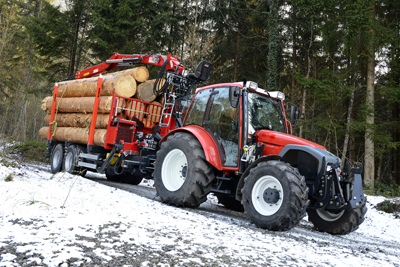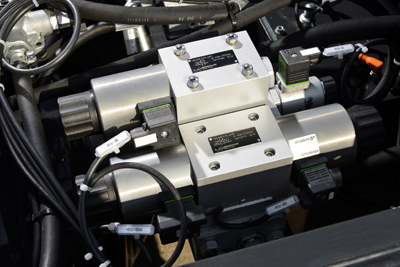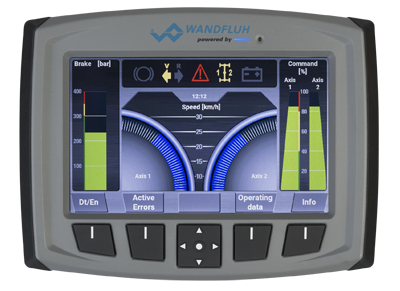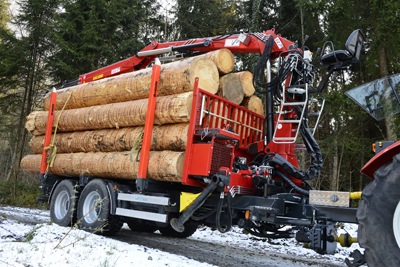Contributed by Adrian Feuz, Wandfluh AG

Wandfluh Programmable Mobile Electronics system controls the drive and braking of a heavy logging trailer.
In industrial applications, a superordinate PLC often takes on the coordination of processes and the control of individual components. With hydraulic functions, for example, position control of a hydraulic axis or pressure control of clamping or pressing actions are controlled by the PLC and corresponding electronics. In this case, the electronic controls only regulate a single function.
The requirements of mobile machines are much more complex. Here, the controls should both coordinate processes and directly control hydraulic valves, as well as take on other electric, non-hydraulic functions.
This also requires a change in thinking in the design of mobile equipment and the cooperation between systems specialists in the fields of hydraulics and electronics. For instance, operations are no longer limited to individual pressure controls. Instead, several machine functions should be coordinated and controlled, and additional sensors need to be read and actuators directly controlled.

WDMFA 10 valves produce the required back-pressure to brake the trailer.
With a new generation of control devices, Wandfluh AG, Frutigen, Switzerland, is able to close this gap and connect its extensive know-how in the field of hydraulics with the technical control requirements of mobile machines.
The new family of devices, called Programmable Mobile Electronics (PME), consists of various electronic modules for operation and control as well as for graphically displaying machine data. As a result of the modular design of these PME devices and simple networking via a CAN bus, the control structure can be decentralized and the system simplified, which can greatly reduce assembly costs.
Extensions of a base system and additional functions can be easily integrated, and the free programmability of the modules leads to greater design flexibility and more-creative engineering solutions. With various displays, flexible I/O devices and keypads, the system can cover many diverse applications. In addition, telemetry modules permit remote access via GSM or Wi-Fi, and enable remote diagnostics, vehicle tracking, and control revisions and updates.

PME graphic display shows system status and diagnostic data, and permits operator adjustments.
As a real-world application, Wandfluh has implemented the hydraulic-electric controls in a logging trailer for forestry applications. Fully loaded, these trailers carry a significant weight which, using conventional technology, requires a large and powerful towing vehicle that is not suitable for narrow roads or rough terrain. In addition, the mechanical brakes of the trailer are not generally designed for high and long-term braking forces. They can overheat, and the engine brake of the tractor cannot sufficiently decelerate the weight of the trailer.
Using Wandfluh hydraulic valves and a PME intelligent control system, the company has now developed a hydraulic drive support and a hydraulic brake. System engineers have been able to fully exploit the inherent flexibility of the different devices in the PME family. For example, the free programmability of the modules lets the software be adapted to match the required functions, and a graphic display reads the status of the operating elements and permits the adjustment and diagnostics of important data. It was straightforward to wire the decentralized input/output modules for sensors and hydraulic valves via the CAN bus, and to easily integrate standard Wandfluh electronics.

Close-up of forestry trailer with PME electrohydraulic controls.
The drive shaft powers two hydraulic pumps, which provide the necessary oil pressure uphill for the drive support. Via an in-cab display in the towing vehicle, the operator can easily adjust electronically-regulated proportional pressure relief valves and provide additional power when needed.
Downhill, the trailer’s axles are hydraulically braked, where the same valves indirectly limit the rotational speed of the axles. The hydraulic motor now pumps the oil, the valves produce the desired backpressure and, in doing so, they brake the trailer. The braking power heats the hydraulic oil which is simply cooled by built-in fans.
The transmission of the two axles can be individually engaged or released to drive at higher speeds on flat terrain. Additional sensors, for example in the drive shaft or the transmission, allow functional analysis and error monitoring in the software. Operation by means of switches and display in the towing vehicle lets the driver constantly keep track of all the important data such as speed, hydraulic pressures and the system status of individual functions. Through creative collaboration between hydraulics and electronics, particularly the PME devices, Wandfluh has been able to carry out the project successfully.
Wandfluh
www.wandfluh.com
Filed Under: Mobile Hydraulic Tips, Slider, Valves & Manifolds